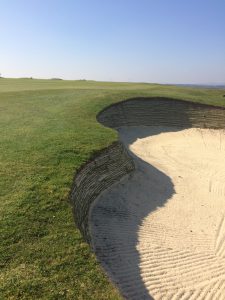Southerndown’s members didn’t notice a bunker was synthetic
Related Articles
When Southerndown GC commissioned a synthetic practice bunker in January 2011 (only the third in the world), it hoped it would lead to a solution to its chronic bunker erosion problems. Poor bunker conditioning threatened its continued hosting of major tournaments and was a source of member and visitor dissatisfaction. Course manager Andrew Mannion had heard that a local engineer, Richard Allen, was looking to trial his revolutionary low maintenance bunker edge design. It was a perfect fit: Southerndown urgently needed a solution, whilst Allen wanted to test his product in the toughest of environments.

The trial proved to Andrew and the greens committee just how resilient the natural looking synthetic revetted face was. How did the club members react? There was no reaction. Why? Because most golfers simply did not notice anything unusual about their new bunker, and six years later members at over one hundred courses around the world are still amazed when the secret of their pristine new bunkers is revealed.

Adaptable to all types of golf courses, the ecobunker system has expanded most rapidly on the exposed links of the UK and Europe. In 2017, Wales’ oldest course, Tenby (1888) joined the likes of Conwy, Pennard, Seaton Carew, Budersand, Rosslare, St Annes, Castletown, Leasowe, Musselburgh Old Links and Winterfield ; the traditional links courses in the ecobunker family, committed to full course improvements, and all determined to ‘Build it Once’.

























